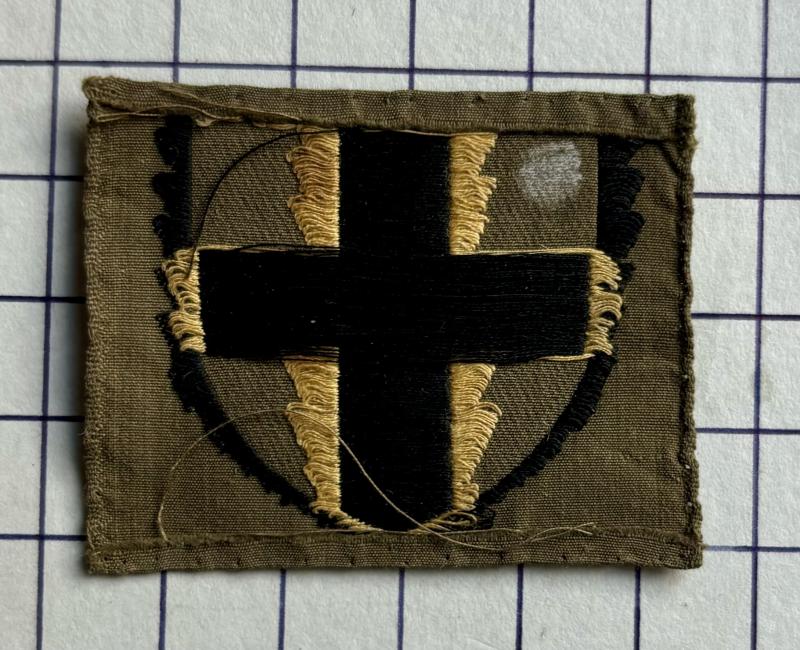WW2 Welch 38th Infantry Division Formation Sign Badge
WWII Welsh 38th Inf Div cloth badge patch. Removed from Battle Dress Uniform. GC. Resembling the flag of Saint David, a yellow cross on a black shield with a yellow border.
The 38th (Welsh) Infantry Division became active on 18 September 1939; its constituent units had already formed and had been administered by the 53rd (Welsh) Infantry Division. The 38th was again composed of the 113th, 114th and 115th Infantry Brigades, and was placed under the initial command of Major-General Geoffrey Raikes.
In May, Major-General A. E. Williams assumed command. The division was initially assigned to Western Command, and by early 1940 was spread out along the River Severn in England and Wales. By summer, the division was under the command of III Corps and was based in North West England, around Liverpool, to conduct manoeuvres and training.
The war-time deployment of the Territorial Army envisioned it being deployed piecemeal, to reinforce the regular army already deployed to the European mainland, as equipment became available. The plan envisioned the deployment of the whole force in waves, as divisions completed their training, with the final divisions being deployed a year after the outbreak of war. As a result, the division did not leave the United Kingdom as the British Expeditionary Force (BEF) was evacuated from France during May and June 1940. On 28 October, Major-General Noel Irwin, who had commanded the 2nd Infantry Division during the latter stages of the fighting in France, was given command of the 38th.
In April 1941, the division was assigned to IV Corps and had moved to Sussex, the 18th Infantry Division having replaced them around Liverpool. In Sussex, the division was held in reserve and placed behind the 47th (London) Infantry Division and the 55th (West Lancashire) Infantry Division which were defending the coast between Bognor Regis – in the west – to Beachy Head in the east. Michael Glover and Jonathan Riley note that while in reserve, the Royal Welch Fusiliers battalions of the 115th Brigade took part in coastal defence duties.
On 15 November 1941, Major-General Arthur Dowler took command of the division. On 1 December 1941, the division was placed on the lower establishment, having been earmarked for a static home defence role.
During 1942, the division was assigned to V Corps and had shifted west to defend the Dorset coastline. On 27 and 28 February, the anti-aircraft platoon of the 4th Battalion, Monmouthshire Regiment, supported Operation Biting, the commando raid on Bruneval, France. On 23 April 1942, Major-General D. C. Butterworth was given command of the division. In July, the division lost the 10th Royal Welch Fusiliers to the Parachute Regiment. The division spent 1943 and early 1944 moving around the country spending time in Kent, Hertfordshire and Northumberland, and were assigned to II and XII Corps. In February 1944, 38th Division provided part of the 'enemy' force in Exercise Eagle, a 12-day pre-invasion training exercise held on the Yorkshire Wolds for VIII Corps, which was to form part of 21st Army Group in the forthcoming Allied invasion of Normandy (Operation Overlord). By March, the 115th Infantry Brigade had formed "'B' Marshalling Area" and was aiding the movement of troops in preparation for Overlord.
The 38th (Welsh) Infantry Division's Second World War shoulder badge, based on the flag of Saint David
By 1944, there were five lower establishment divisions allocated to home defence duties: the 38th, the 45th, the 47th (London), the 55th (West Lancashire) and the 61st Infantry divisions. These five divisions had a combined total of 17,845 men. Of this number, around 13,000 were available as replacements for the 21st Army Group fighting in France.183f The remaining 4,800 men were considered ineligible for service abroad at that time for a variety of reasons, including a lack of training, or being medically unfit. Over the next six months, up to 75 per cent of these men would be deployed to reinforce 21st Army Group after the completion of their training and certification of fitness.185 Specifically, the vast majority of the 1st Brecknockshire Battalion, South Wales Borderers were deployed to Normandy at the end of June as replacements to reinforce 21st Army Group, and by mid-July so had the 2nd Battalion, Herefordshire Light Infantry, resulting in that battalion being disbanded.170186 Historian Stephen Hart commented that, by September, 21st Army Group "had bled Home Forces dry of draftable riflemen" after the losses suffered during the Battle of Normandy, leaving the army in Britain, with the exception of the 52nd (Lowland) Infantry Division, with just "young lads, old men and the unfit".
Compounding the loss of men to reinforce 21st Army Group, on 3 July the 115th Infantry Brigade was withdrawn from the division. The brigade was earmarked for an operation to liberate the Channel Islands and was re-designated Force 135. Ultimately such an operation did not take place and the brigade was deployed to mainland Europe. During August, the 38th (Welsh) Infantry Division began to disperse. On 15 August, the divisional headquarters ceased commanding any subordinate units and by the end of the month the division was disbanded.
Code: 571


